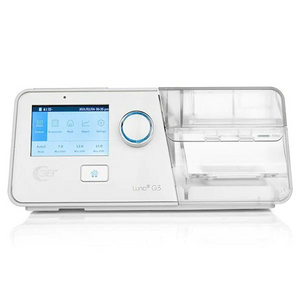- Store information block
📢 Great News! We offer FREE SHIPPING on All Orders over $99.00! 🚚✨
Bilevel machines (BiPAP) are sleep apnea devices that deliver two pressure settings. One pressure is set to your inhalation (IPAP), and one is for your exhalation (EPAP). An example of a bilevel setting is 14 cm/10 cm H2O. Bilevels are most often prescribed for people who are intolerant of high CPAP pressures or have limited lung function that restricts exhalation and can cause CO2 retention. Bilevel devices are available in fixed pressure, auto adjusting, and advanced models. Please note, bilevel is the general term for this type of therapy, BiPAP is a trademarked name for Philips Respironics models, and VPAP™ is a trademark name of ResMed devices. A variable PAP machine is similar in function to BiPAP machines. Both feature two pressure levels to match a patient’s natural inhalation and exhalation patterns. Like a CPAP machine, the device is also used to treat sleep apnea.
The machine is used for bilevel positive airway pressure therapy. This is often recommended as a treatment for chronic obstructive pulmonary disease (COPD), high CPAP Pressures causing the user to become intolerable to CPAP Pressure and obstructive sleep apnea.
Both have their pros and cons. The difference is that a BiPAP machine includes a breath-timing feature that gauges the number of breaths a person should take per minute while the CPAP machine can only be set to a single pressure throughout the night. This can be difficult for the patient to exhale against, feeling like they have to force out their breathing.
Comparing them to CPAP machines, bilevel machines come in two pressure settings: one for inhalation pressure (IPAP) and one for exhalation (EPAP). The steady stream of pressurized air getting into the patient’s airways keeps them from collapsing and causing apnea. While CPAP machines are also used for the same goal, they can only be set to deliver the same amount of pressure continuously throughout the night. BiPAP is often recommended for the treatment of sleep apnea, especially when CPAP isn’t effective.
A BiPAP machine may use oxygen when the therapy is done in conjunction with oxygen therapy. Dual oxygen therapy using a nasal cannula and a BiPAP machine is especially helpful for patients who can’t maintain good oxygen saturation while on the treatment. The difference of CPAP and BiPAP compared to oxygen therapy is that oxygen from an O2 tank is not customized to the patient’s specific needs. It won’t deliver pressure to the airways, so it can’t adapt to one’s breathing patterns.




$0.00
There are no products in comparison list.
Please select at least 2 products to compare.
